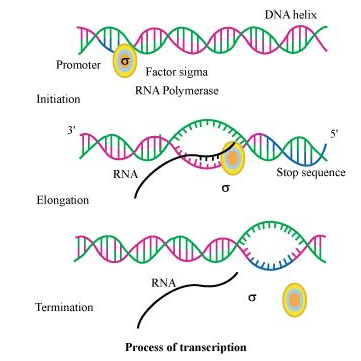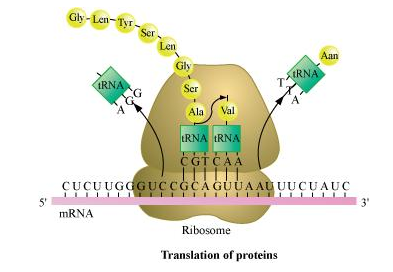Briefly describe the following:
(a) Transcription
(b) Polymorphism
(c) Translation
(d) Bioinformatics
(a) Transcription
Transcription is the process of synthesis of RNA from DNA template. A segment of DNA gets copied into mRNA during the process. The process of transcription starts at the promoter region of the template DNA and terminates at the terminator region. The segment of DNA between these two regions is known as transcription unit. The transcription requires RNA polymerase enzyme, a DNA template, four types of ribonucleotides, and certain cofactors such as Mg2+.
The three important events that occur during the process of transcription are as follows.
(i) Initiation
(ii) Elongation
(iii) Termination
The DNA-dependent RNA polymerase and certain initiation factors (σ) bind at the double stranded DNA at the promoter region of the template strand and initiate the process of transcription. RNA polymerase moves along the DNA and leads to the unwinding of DNA duplex into two separate strands. Then, one of the strands, called sense strand, acts as template for mRNA synthesis. The enzyme, RNA polymerase, utilizes nucleoside triphosphates (dNTPs) as raw material and polymerizes them to form mRNA according to the complementary bases present on the template DNA. This process of opening of helix and elongation of polynucleotide chain continues until the enzyme reaches the terminator region. As RNA polymerase reaches the terminator region, the newly synthesized mRNA transcripted along with enzyme is released. Another factor called terminator factor (ρ) is required for the termination of the transcription.

(b) Polymorphism
Polymorphism is a form of genetic variation in which distinct nucleotide sequence can exist at a particular site in a DNA molecule. This heritable mutation is observed at a high frequency in a population. It arises due to mutation either in somatic cell or in the germ cells. The germ cell mutation can be transmitted from parents to their offsprings. This results in accumulation of various mutations in a population, leading to variation and polymorphism in the population. This plays a very important role in the process of evolution and speciation.
(c) Translation
Translation is the process of polymerizing amino acid to form a polypeptide chain. The triplet sequence of base pairs in mRNA defines the order and sequence of amino acids in a polypeptide chain.
The process of translation involves three steps.
(i) Initiation
(ii) Elongation
(iii) Termination
During the initiation of the translation, tRNA gets charged when the amino acid binds to it using ATP. The start (initiation) codon (AUG) present on mRNA is recognized only by the charged tRNA. The ribosome acts as an actual site for the process of translation and contains two separate sites in a large subunit for the attachment of subsequent amino acids. The small subunit of ribosome binds to mRNA at the initiation codon (AUG) followed by the large subunit. Then, it initiates the process of translation. During the elongation process, the ribosome moves one codon downstream along with mRNA so as to leave the space for binding of another charged tRNA. The amino acid brought by tRNA gets linked with the previous amino acid through a peptide bond and this process continues resulting in the formation of a polypeptide chain. When the ribosome reaches one or more STOP codon (VAA, UAG, and UGA), the process of translation gets terminated. The polypeptide chain is released and the ribosomes get detached from mRNA.

(d) Bioinformatics
Bioinformatics is the application of computational and statistical techniques to the field of molecular biology. It solves the practical problems arising from the management and analysis of biological data. The field of bioinformatics developed after the completion of human genome project (HGP). This is because enormous amount of data has been generated during the process of HGP that has to be managed and stored for easy access and interpretation for future use by various scientists. Hence, bioinformatics involves the creation of biological databases that store the vast information of biology.
It develops certain tools for easy and efficient access to the information and its utilization. Bioinformatics has developed new algorithms and statistical methods to find out the relationship between the data, to predict protein structure and their functions, and to cluster the protein sequences into their related families.
Click here to get exam-ready with eSaral
For making your preparation journey smoother of JEE, NEET and Class 8 to 10, grab our app now.
